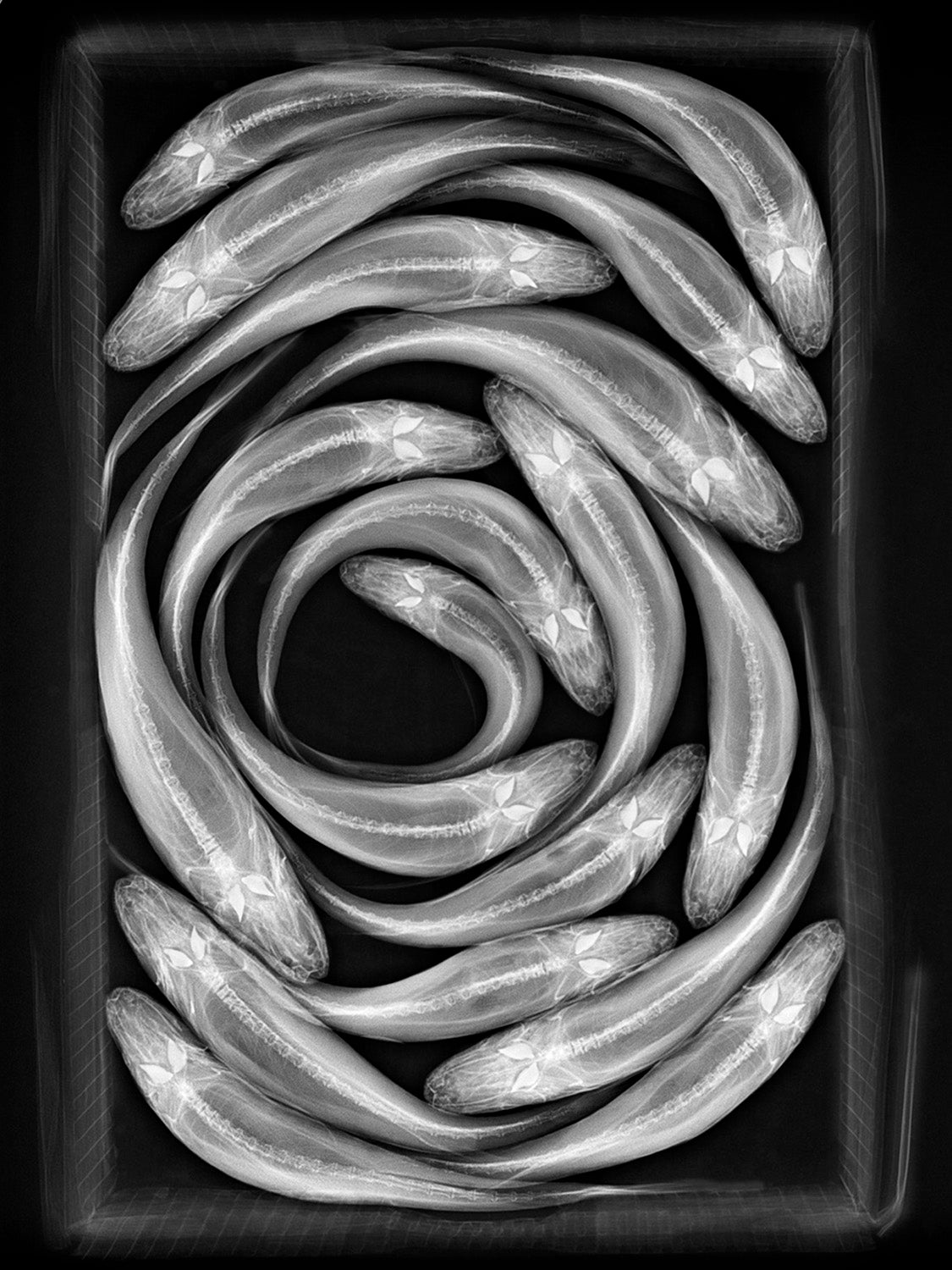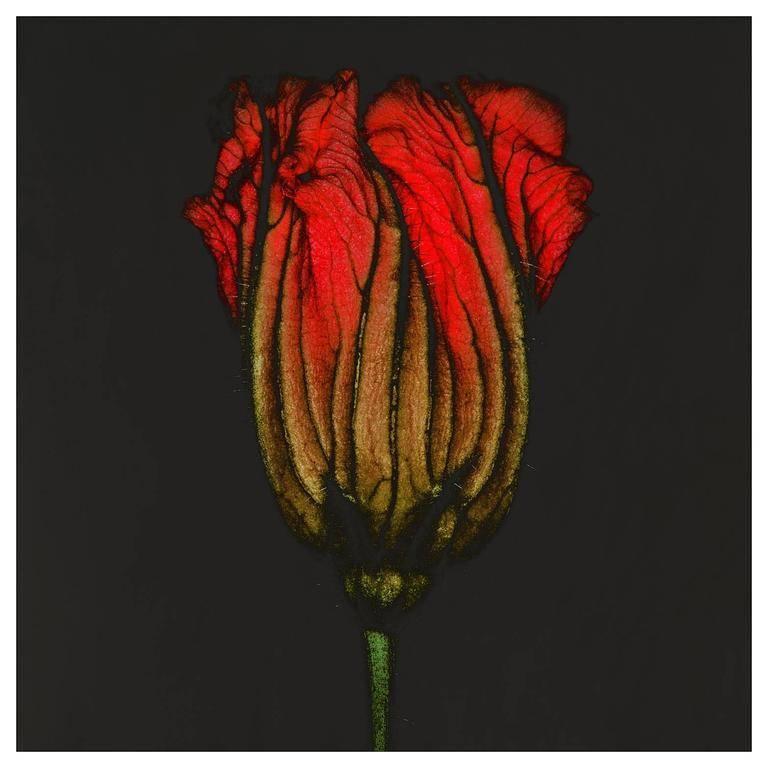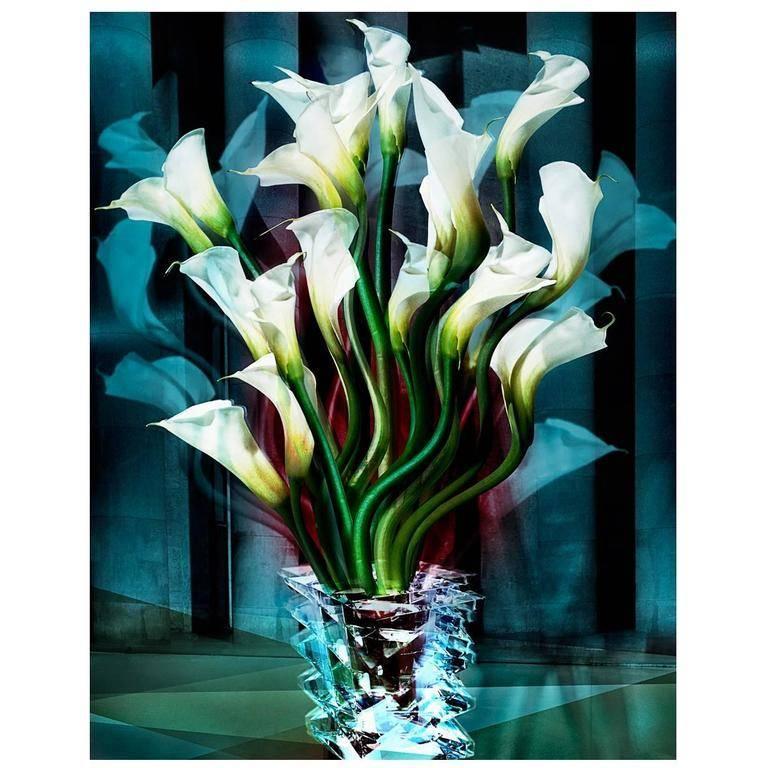Items Similar to "Clarinet", 1997
Want more images or videos?
Request additional images or videos from the seller
1 of 5
Steve Miller"Clarinet", 19971997
1997
About the Item
While all photography arrests motion, it is only the X-ray that allows us to climb inside a particular moment and subject and parse the structure of its beauty from within. Miller’s work lifts the lid off a hidden domain, revealing the stilled and remarkable innards of things we pass by every day. Orchid bulbs perch on lacy roots, music thrums from a plucked string, a foot punches a ball into the air. Miller removes plants, musical instruments, and soccer balls from their usual context and fixes them under the omniscient, scrutinizing eye of the digital X-ray. The inner world rises to the outer. Smoky, ethereal tulips bend, mid-wilt; seeds nestle within nearly invisible pods; the guitar’s translucent body rests in its case, snug as if in an ancient sarcophagus. Miller distills all action, feeling, and process so that only the essential remains, and in carefully rendered black, white, and film-noir gray, the essential is both clinical and glamorous.
What was hidden is now revealed, and the empty space within his subjects speaks to their potential fullness. At the same time, that new vision brings with it an unsettling awareness of our own inner workings, our fundamental material essence, and ultimately, our human susceptibility to the processes of time.
In the past 25 years, Steve Miller has presented 31 solo exhibitions at major institutions in the United States, China, France, and Germany. His exhibitions have been reviewed in Le Monde, Süddeutsche Zeitung, The New York Times, The Boston Globe, ArtForum, ARTnews, and Art in America. Miller was one of the first artists to experiment with computers in the early 1980’s, and his work today continues to integrate science and technology with fine art.
Listing is for UNFRAMED print. Inquire within for framing.
Edition 1 of 21.
If the exhibition piece is sold or the customer orders a different print size, the photograph is produced upon purchase. Please allow two weeks for production.
Shipping time depends on method of shipping.
Price is subject to availability. The Robin Rice Gallery reserves the right to adjust this price depending on the current edition of the photograph.
Still life, black and white, musical instrument, clarinet, music, x-ray, oversized por
- Creator:Steve Miller (1951, American)
- Creation Year:1997
- Dimensions:Height: 24 in (60.96 cm)Width: 16 in (40.64 cm)
- Medium:
- Movement & Style:
- Period:
- Framing:Framing Options Available
- Condition:
- Gallery Location:Hudson, NY
- Reference Number:1stDibs: G11012711124

About the Seller
5.0
Vetted Seller
These experienced sellers undergo a comprehensive evaluation by our team of in-house experts.
Established in 1990
1stDibs seller since 2010
119 sales on 1stDibs
Typical response time: 5 hours
- ShippingRetrieving quote...Ships From: New York, NY
- Return PolicyThis item cannot be returned.
More From This SellerView All
- "Solex Carburetor 1928", 2007By Ian GittlerLocated in Hudson, NYIan Gittler’s Motor Art series-photographs of century-old engine parts, gears, sparkplugs, and brand tags-offers respite from the digital fetishism, overexposure and one-hundred-forty-character bursts of communication that seem to define our era. Gittler is no luddite, he loves his iPhone. But these images, often obscuring the objects beyond identification, take unsentimental pleasure in elements of weight, ground, volume and permanence that are more closely associated with a bygone heyday of industrialization. These photographs are about a tangible physical experience, about moving parts. Gittler’s expert printing-his ability to see the potential in a frame and employ the techniques necessary to articulate that vision on paper-brings the work to life. There’s wit in the brand iconography and a documentary component, but Gittler resists prescribing interpretations, saying subtext isn’t the point. His use of extremely shallow depth of field, intense contrast and exploded grain is muscular and poetic. But subtext is relevant. Although Robin Rice first approached Ian Gittler about his vector-based art on photo paper, the gallerist challenged him to create a series of photographs with that kind of machismo. As a native New Yorker who was marched through the halls of MOMA as a toddler, Gittler’s inspiration-his idea of macho-has less to do with cowboys and racecar drivers than with Franz Kline brushstrokes and modernist design. For Gittler, macho means the maximum amount of black ink that can lie across a sheet of photo paper. That kind of force. He narrowed his field of view for this series-often to a centimeter or two-in order to achieve a purely visual, visceral response. Gittler titled the work Motor Art in tribute to the 1934 Museum of Modern Art exhibit, Machine Art. Upon its sixtieth anniversary, Phillip Johnson wrote of the show (and of his own essay for its original opening), “The thrust was clear: anti-handicraft, industrial methods alone satisfied our age; Platonic dreams of perfection were the ideal.” Ian Gittler photographs, draws, writes, and makes music. He has created album covers for Willie Nelson, Roy Hargrove...Category
21st Century and Contemporary Contemporary Black and White Photography
MaterialsArchival Paper, Pigment
- "Trip Hammer", 2010By Ian GittlerLocated in Hudson, NYIan Gittler’s Motor Art series-photographs of century-old engine parts, gears, sparkplugs, and brand tags-offers respite from the digital fetishism, overexposure and one-hundred-forty-character bursts of communication that seem to define our era. Gittler is no luddite, he loves his iPhone. But these images, often obscuring the objects beyond identification, take unsentimental pleasure in elements of weight, ground, volume and permanence that are more closely associated with a bygone heyday of industrialization. These photographs are about a tangible physical experience, about moving parts. Gittler’s expert printing-his ability to see the potential in a frame and employ the techniques necessary to articulate that vision on paper-brings the work to life. There’s wit in the brand iconography and a documentary component, but Gittler resists prescribing interpretations, saying subtext isn’t the point. His use of extremely shallow depth of field, intense contrast and exploded grain is muscular and poetic. But subtext is relevant. Although Robin Rice first approached Ian Gittler about his vector-based art on photo paper, the gallerist challenged him to create a series of photographs with that kind of machismo. As a native New Yorker who was marched through the halls of MOMA as a toddler, Gittler’s inspiration-his idea of macho-has less to do with cowboys and racecar drivers than with Franz Kline brushstrokes and modernist design. For Gittler, macho means the maximum amount of black ink that can lie across a sheet of photo paper. That kind of force. He narrowed his field of view for this series-often to a centimeter or two-in order to achieve a purely visual, visceral response. Gittler titled the work Motor Art in tribute to the 1934 Museum of Modern Art exhibit, Machine Art. Upon its sixtieth anniversary, Phillip Johnson wrote of the show (and of his own essay for its original opening), “The thrust was clear: anti-handicraft, industrial methods alone satisfied our age; Platonic dreams of perfection were the ideal.” Ian Gittler photographs, draws, writes, and makes music. He has created album covers for Willie Nelson, Roy Hargrove...Category
21st Century and Contemporary Contemporary Black and White Photography
MaterialsArchival Paper, Pigment
- "Marston Excelsior", 2007By Ian GittlerLocated in Hudson, NYIan Gittler’s Motor Art series-photographs of century-old engine parts, gears, sparkplugs, and brand tags-offers respite from the digital fetishism, overexpo...Category
21st Century and Contemporary Contemporary Black and White Photography
MaterialsArchival Paper, Pigment
- "Pressure Gauge", 2007By Ian GittlerLocated in Hudson, NYIan Gittler’s Motor Art series-photographs of century-old engine parts, gears, sparkplugs, and brand tags-offers respite from the digital fetishism, overexposure and one-hundred-forty-character bursts of communication that seem to define our era. Gittler is no luddite, he loves his iPhone. But these images, often obscuring the objects beyond identification, take unsentimental pleasure in elements of weight, ground, volume and permanence that are more closely associated with a bygone heyday of industrialization. These photographs are about a tangible physical experience, about moving parts. Gittler’s expert printing-his ability to see the potential in a frame and employ the techniques necessary to articulate that vision on paper-brings the work to life. There’s wit in the brand iconography and a documentary component, but Gittler resists prescribing interpretations, saying subtext isn’t the point. His use of extremely shallow depth of field, intense contrast and exploded grain is muscular and poetic. But subtext is relevant. Although Robin Rice first approached Ian Gittler about his vector-based art on photo paper, the gallerist challenged him to create a series of photographs with that kind of machismo. As a native New Yorker who was marched through the halls of MOMA as a toddler, Gittler’s inspiration-his idea of macho-has less to do with cowboys and racecar drivers than with Franz Kline brushstrokes and modernist design. For Gittler, macho means the maximum amount of black ink that can lie across a sheet of photo paper. That kind of force. He narrowed his field of view for this series-often to a centimeter or two-in order to achieve a purely visual, visceral response. Gittler titled the work Motor Art in tribute to the 1934 Museum of Modern Art exhibit, Machine Art. Upon its sixtieth anniversary, Phillip Johnson wrote of the show (and of his own essay for its original opening), “The thrust was clear: anti-handicraft, industrial methods alone satisfied our age; Platonic dreams of perfection were the ideal.” Ian Gittler photographs, draws, writes, and makes music. He has created album covers for Willie Nelson, Roy Hargrove...Category
21st Century and Contemporary Contemporary Black and White Photography
MaterialsArchival Paper, Pigment
- "Cummins Steam Pump", 2007By Ian GittlerLocated in Hudson, NYIan Gittler’s Motor Art series-photographs of century-old engine parts, gears, sparkplugs, and brand tags-offers respite from the digital fetishism, overexposure and one-hundred-forty-character bursts of communication that seem to define our era. Gittler is no luddite, he loves his iPhone. But these images, often obscuring the objects beyond identification, take unsentimental pleasure in elements of weight, ground, volume and permanence that are more closely associated with a bygone heyday of industrialization. These photographs are about a tangible physical experience, about moving parts. Gittler’s expert printing-his ability to see the potential in a frame and employ the techniques necessary to articulate that vision on paper-brings the work to life. There’s wit in the brand iconography and a documentary component, but Gittler resists prescribing interpretations, saying subtext isn’t the point. His use of extremely shallow depth of field, intense contrast and exploded grain is muscular and poetic. But subtext is relevant. Although Robin Rice first approached Ian Gittler about his vector-based art on photo paper, the gallerist challenged him to create a series of photographs with that kind of machismo. As a native New Yorker who was marched through the halls of MOMA as a toddler, Gittler’s inspiration-his idea of macho-has less to do with cowboys and racecar drivers than with Franz Kline brushstrokes and modernist design. For Gittler, macho means the maximum amount of black ink that can lie across a sheet of photo paper. That kind of force. He narrowed his field of view for this series-often to a centimeter or two-in order to achieve a purely visual, visceral response. Gittler titled the work Motor Art in tribute to the 1934 Museum of Modern Art exhibit, Machine Art. Upon its sixtieth anniversary, Phillip Johnson wrote of the show (and of his own essay for its original opening), “The thrust was clear: anti-handicraft, industrial methods alone satisfied our age; Platonic dreams of perfection were the ideal.” Ian Gittler photographs, draws, writes, and makes music. He has created album covers for Willie Nelson, Roy Hargrove...Category
21st Century and Contemporary Contemporary Still-life Photography
MaterialsArchival Paper, Pigment
- "Ideal", 2007By Ian GittlerLocated in Hudson, NY“IDEAL" features a 1.5 horsepower lawnmower engine manufactured in 1924 that still works. And the brand name-Ideal-speaks to an attitude about fabrication and manufacture linking pri...Category
21st Century and Contemporary Contemporary Black and White Photography
MaterialsArchival Paper, Pigment
You May Also Like
- 'Tulip Awakening' Large Scale Photograph bold flower pastel red orange whiteBy Sophia MilliganLocated in Penzance, GB'Tulip, Awakening' 60 x 40" edition Limited edition archival photograph, hand signed and numbered. Unframed _________________ Gauzy afternoon light, the tulips are stretching softly,...Category
2010s Contemporary Color Photography
MaterialsArchival Ink, Archival Paper, Giclée, Archival Pigment
- 'Silver basket, White Tulips' Limited Edition Photograph. Minimal Still LifeBy Sophia MilliganLocated in Penzance, GB'Silver basket 1761, White Tulips, Blue Hyacinths' Limited edition (1 of 25) archival black and white photograph. Unframed. _________________ Sophia's po...Category
2010s Contemporary Still-life Photography
MaterialsArchival Paper, Photographic Paper, Archival Pigment
- Calla Lilies • # 2 of 3 • 84 cm x 59 cmBy Angelika BuettnerLocated in Aramits, Nouvelle-AquitaineCalla Lilies • 2005 • Edition of 18 prints in 3 different sizes. All prints are numbered and signed. Printed on Hahnemühle Archival Paper. Three different sizes are available, the ...Category
Early 2000s Contemporary Still-life Photography
MaterialsArchival Paper, Archival Pigment, Digital Pigment
- Pumpkin Blossom - #3 of 7By Carsten WitteLocated in Aramits, Nouvelle-AquitainePrinted on archival fine art paper and signed, dated and numbered by the artist. Edition # 3 of 7. About the artist: "I always felt that plants have a secret life. First, you don't...Category
2010s Contemporary Still-life Photography
MaterialsArchival Paper, Archival Pigment
- Calla Lilies • # 3 of 9 • 42 cm x 29 cmBy Angelika BuettnerLocated in Aramits, Nouvelle-AquitaineCalla Lilies • 2005 • Edition of 18 prints in 3 different sizes. All prints are numbered and signed. Printed on Hahnemühle Archival Paper. Three different sizes are available, the ...Category
Early 2000s Contemporary Still-life Photography
MaterialsArchival Paper, Archival Pigment, Digital Pigment
- Calla Lilies • # 3 of 6 • 59 cm x 42 cmBy Angelika BuettnerLocated in Aramits, Nouvelle-AquitaineCalla Lilies • 2005 • Edition of 18 prints in 3 different sizes. All prints are numbered and signed. Printed on Hahnemühle Archival Paper. Three different sizes are available, the ...Category
Early 2000s Contemporary Still-life Photography
MaterialsArchival Pigment, Archival Paper, Digital Pigment
Recently Viewed
View AllMore Ways To Browse
Vintage X Rays
Photography Boston
New York Used Instruments
Outer Space Photography
Black White Lid
Music Art Guitar
Retro String Art
Vintage Black Guitar
Art With Music Instrument
Soccer Art
American Vintage Guitars
1980s Roots
Vintage Climbing Frame
Miller Action
Music Instruments Vintage Musical Instruments
Vintage Film Noir
Oversized Still Life Photography
Oversized Ball





